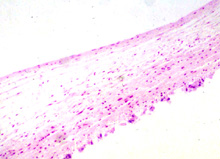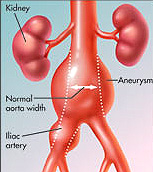 Heart valves must be shaped
so as to exactly
fit together and prevent backflow of blood. If congenitally abnormal
or misshapen due to infection or other problem, regurgitation of
blood back through the valve will occur and this is detectable as a
murmur. Heart valves must be shaped
so as to exactly
fit together and prevent backflow of blood. If congenitally abnormal
or misshapen due to infection or other problem, regurgitation of
blood back through the valve will occur and this is detectable as a
murmur.Study of the circulatory system
outside the heart includes the arteries and veins, their smaller
branches, and the microvasculature between the arterial supply and
the venous system. The
relative thicknesses and the general shapes of these vessels in
transverse section is shown in the diagram.
Arteries and Arterioles
Examine a section of the aorta and identify
- The three basic layers or tunics (intima,
media, and adventitia) of this large vessel
- Note their distinctive features.
Which is thicker in the media:
one of the layers of smooth muscle or a layer of elastic material?
Clinical note: Degeneration of
components such as elastic fibers in the tunica media of arteries
weakens the arterial wall and can lead to blood leakage into or
through the wall (a “dissected” artery) or to formation of a
circumscribed bulge called an aneurysm. Either type of defect can
have disastrous results in a major artery such as the aorta.
Now for muscular
and elastic arteries. |